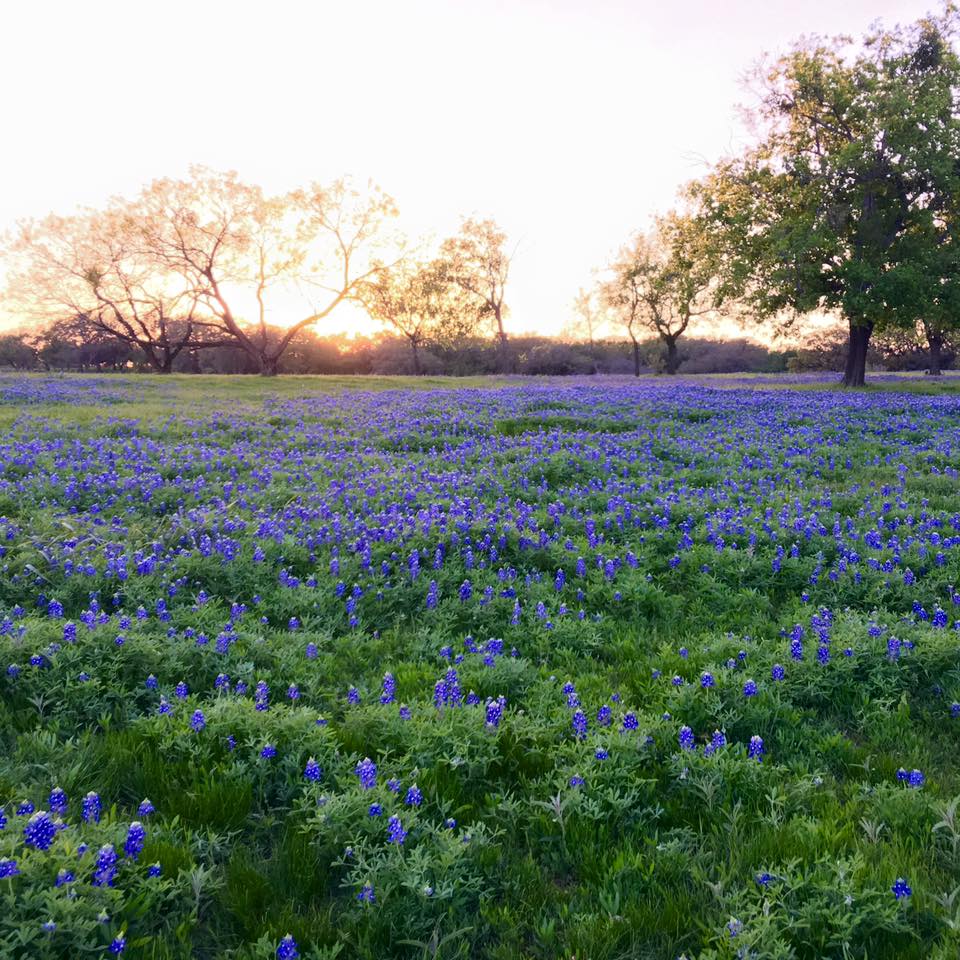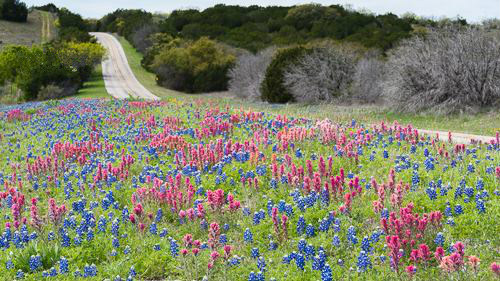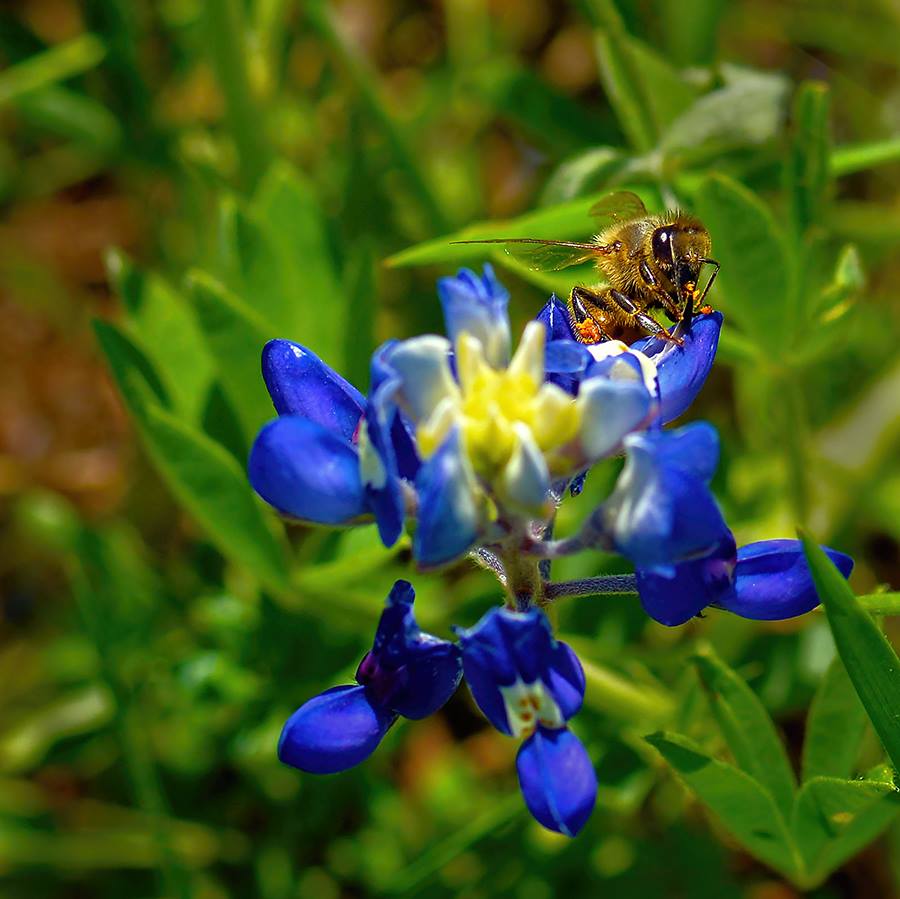True blue is the rarest colour. Very often, what is described as blue is really purple. Bluebells, are purple. Some delphiniums are a good blue,Cornflowers, and Salvia Patens i think is the colour of blue velvet.
There is a pink and also a white Bluebonnet (both pretty rare though) but the blue ones really are blue, especially when viewed up close and fully opened up. They tend to be most blue at the lower, wider end. The newest buds to open can look a little purple at first and particularly from a distance when the sunrise or sunset hues are on them.
This photo was taken this week around Waco, just north of me. I don't recognize the pink wildflower amongst the bluebonnets here. but definitely not the pink bluebonnets, as they are very light pink color. But they sure are pretty aren't they? Our color will be tapering off the first two weeks in April. Always sad to see the color end each year.
Photo courtesy of Paul Gray's Gallery shared on Facebook, but this photographer demonstrates just how blue our bluebonnets really are up close. A lovely bee is in heaven on this one.
These were taken this week in Ennis, TX, near Dallas. In another week they will all be nearly gone. Thought you might enjoy how lush and green everything is in Texas right now. In 3 months time, the grass will be browning off state-wide from our heat most likely, so we have to enjoy the green you folks are accustomed to year-round while we can. Spring is such a brief window in Texas.
If you do, BeausMum, be sure you plant them in a wide-open field where they will naturalize over the years, where you do not want a mowed, manicured garden lawn. The clump will get larger and larger each year as they drop mature seeds on the ground where they stand. The seeds can take 5 years to germinate, so the naturalizing (or potential invasiveness, depending on how you chose to look at the habit) is a very slow process actually. Anytime you want to stop their spread, just mow them down BEFORE the seed pods have dried and opened up. That's the surest way to kill off a field of bluebonnets, as I did it intentionally in my front lawn at my last house over two seasons. As the main plants die off and you wait for them to grown over open/drop their seed pod contents, you won't like the appearance in your formal garden. Trust me on that one. They are best suited for the country and rural settings as seen in the photos I have been sharing, in other words, not close to your manicured garden lawn where they will happily move right in over time.
Sorry Peggy I have just seen your reply. Thank you for all the info. I will get one this weekend and show you. I doubt very much it will be as rampant or as gorgeous as the species you have in Texas
Posts
True blue is the rarest colour. Very often, what is described as blue is really purple. Bluebells, are purple. Some delphiniums are a good blue,Cornflowers, and Salvia Patens i think is the colour of blue velvet.
There is a pink and also a white Bluebonnet (both pretty rare though) but the blue ones really are blue, especially when viewed up close and fully opened up. They tend to be most blue at the lower, wider end. The newest buds to open can look a little purple at first and particularly from a distance when the sunrise or sunset hues are on them.

BEAUTIFUL ???
This photo was taken this week around Waco, just north of me. I don't recognize the pink wildflower amongst the bluebonnets here. but definitely not the pink bluebonnets, as they are very light pink color. But they sure are pretty aren't they? Our color will be tapering off the first two weeks in April. Always sad to see the color end each year.
Photo courtesy of Paul Gray's Gallery shared on Facebook, but this photographer demonstrates just how blue our bluebonnets really are up close. A lovely bee is in heaven on this one.

These were taken this week in Ennis, TX, near Dallas. In another week they will all be nearly gone. Thought you might enjoy how lush and green everything is in Texas right now. In 3 months time, the grass will be browning off state-wide from our heat most likely, so we have to enjoy the green you folks are accustomed to year-round while we can. Spring is such a brief window in Texas.
Absolutely gorgeous Peggy ?
I'm not sure but think the plant specialist nursery I went to yesterday had something similar. Hmmm think I will call them later and reserve if yes ?
If you do, BeausMum, be sure you plant them in a wide-open field where they will naturalize over the years, where you do not want a mowed, manicured garden lawn. The clump will get larger and larger each year as they drop mature seeds on the ground where they stand. The seeds can take 5 years to germinate, so the naturalizing (or potential invasiveness, depending on how you chose to look at the habit) is a very slow process actually. Anytime you want to stop their spread, just mow them down BEFORE the seed pods have dried and opened up. That's the surest way to kill off a field of bluebonnets, as I did it intentionally in my front lawn at my last house over two seasons. As the main plants die off and you wait for them to grown over open/drop their seed pod contents, you won't like the appearance in your formal garden. Trust me on that one. They are best suited for the country and rural settings as seen in the photos I have been sharing, in other words, not close to your manicured garden lawn where they will happily move right in over time.
Last edited: 09 April 2017 17:30:26
Sorry Peggy I have just seen your reply. Thank you for all the info. I will get one this weekend and show you. I doubt very much it will be as rampant or as gorgeous as the species you have in Texas